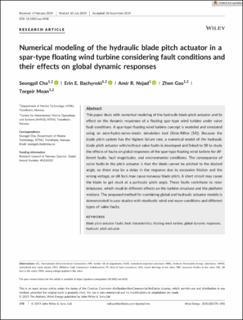| dc.contributor.author | Cho, Seongpil | |
| dc.contributor.author | Bachynski, Erin Elizabeth | |
| dc.contributor.author | Rasekhi Nejad, Amir | |
| dc.contributor.author | Gao, Zhen | |
| dc.contributor.author | Moan, Torgeir | |
| dc.date.accessioned | 2021-02-15T08:49:51Z | |
| dc.date.available | 2021-02-15T08:49:51Z | |
| dc.date.created | 2020-01-31T14:53:26Z | |
| dc.date.issued | 2020 | |
| dc.identifier.citation | Wind Energy. 2020, 23 (2), 370-390. | en_US |
| dc.identifier.issn | 1095-4244 | |
| dc.identifier.uri | https://hdl.handle.net/11250/2727969 | |
| dc.description.abstract | This paper deals with numerical modeling of the hydraulic blade pitch actuator and its effect on the dynamic responses of a floating spar‐type wind turbine under valve fault conditions. A spar‐type floating wind turbine concept is modeled and simulated using an aero‐hydro‐servo‐elastic simulation tool (Simo‐Riflex [SR]). Because the blade pitch system has the highest failure rate, a numerical model of the hydraulic blade pitch actuator with/without valve faults is developed and linked to SR to study the effects of faults on global responses of the spar‐type floating wind turbine for different faults, fault magnitudes, and environmental conditions. The consequence of valve faults in the pitch actuator is that the blade cannot be pitched to the desired angle, so there may be a delay in the response due to excessive friction and the wrong voltage, or slit lock may cause runaway blade pitch. A short circuit may cause the blade to get stuck at a particular pitch angle. These faults contribute to rotor imbalance, which result in different effects on the turbine structure and the platform motions. The proposed method for combining global and hydraulic actuator models is demonstrated in case studies with stochastic wind and wave conditions and different types of valve faults. | en_US |
| dc.language.iso | eng | en_US |
| dc.publisher | Wiley | en_US |
| dc.rights | Attribution-NonCommercial-NoDerivatives 4.0 Internasjonal | * |
| dc.rights.uri | http://creativecommons.org/licenses/by-nc-nd/4.0/deed.no | * |
| dc.title | Numerical modeling of the hydraulic blade pitch actuator in a spar‐type floating wind turbine considering fault conditions and their effects on global dynamic responses | en_US |
| dc.type | Peer reviewed | en_US |
| dc.type | Journal article | en_US |
| dc.description.version | publishedVersion | en_US |
| dc.source.pagenumber | 370-390 | en_US |
| dc.source.volume | 23 | en_US |
| dc.source.journal | Wind Energy | en_US |
| dc.source.issue | 2 | en_US |
| dc.identifier.doi | 10.1002/we.2438 | |
| dc.identifier.cristin | 1788508 | |
| dc.relation.project | Norges forskningsråd: 223254 | en_US |
| dc.description.localcode | © 2019 The Authors. Wind Energy published by John Wiley & Sons Ltd This is an open access article under the terms of the Creative Commons Attribution‐NonCommercial‐NoDerivs License, which permits use and distribution in any medium, provided the original work is properly cited, the use is non‐commercial and no modifications or adaptations are made. | en_US |
| cristin.ispublished | true | |
| cristin.fulltext | postprint | |
| cristin.fulltext | original | |
| cristin.qualitycode | 2 | |

